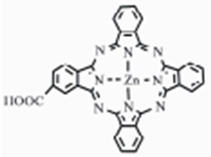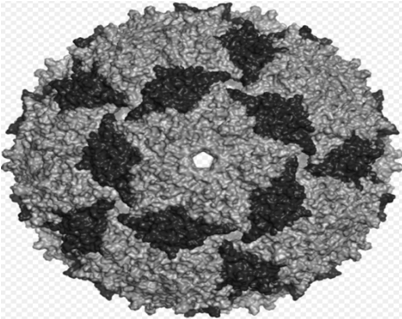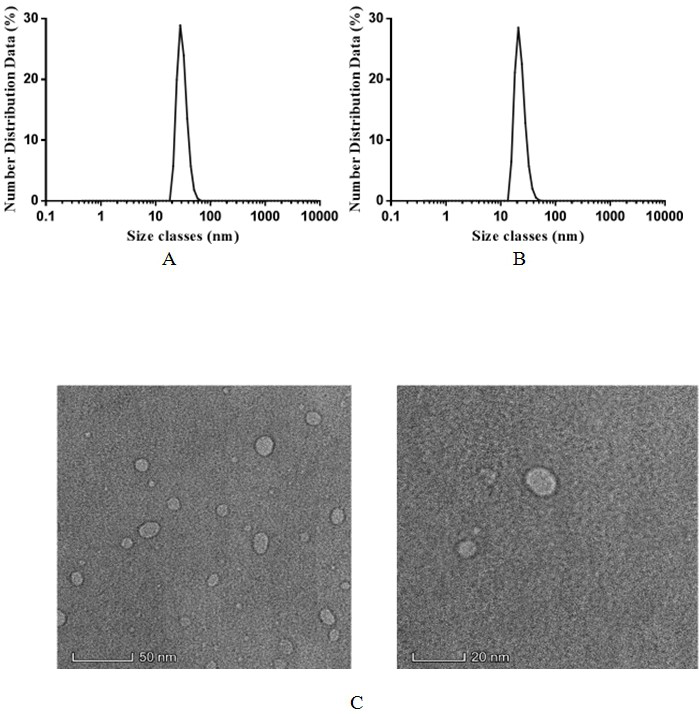A preparation method of ms2 protein nanoparticle coupling monocarboxyphthalocyanine zinc and its application in anti-breast cancer
A technology of nanoparticles and zinc phthalocyanine, applied in the preparation of anti-breast cancer drugs, in the field of preparation of monocarboxyzinc phthalocyanine nanoparticles, can solve the problems of toxic and side effects, short half-life in vivo, poor water solubility, etc. Uniform diameter, reduce drug side effects, and achieve controllable effects
- Summary
- Abstract
- Description
- Claims
- Application Information
AI Technical Summary
Problems solved by technology
Method used
Image
Examples
Embodiment 1
[0031] A method for preparing MS2 protein nanoparticles, comprising the steps of:
[0032] (1) Express MS2 protein in Escherichia coli, centrifuge the crushed bacteria at high speed to remove the precipitate, put the supernatant in a water bath at 37 ℃ for 8 hours, and digest the residual RNA in the supernatant with the nuclease of the bacterial cells themselves And DNA, virus-like particles are resistant to RNase, so the RNA wrapped by the coat protein is not digested;
[0033] (2) Add solid NaCl to a final concentration of 1 mol / L, and ice-bath for 1 hour. Centrifuge at 4°C and 12000 r / min for 10 minutes to remove bacterial debris, and transfer the supernatant to another clean centrifuge tube;
[0034] (3) Add solid polyethylene glycol PEG6000 to a final concentration of 10% (W / V), shake at 37°C for 30 minutes, and place in an ice bath overnight to precipitate the virus-like particles;
[0035] (4) Centrifuge at 4°C and 12,000 rpm for 10 min, recover the precipitated virus-l...
Embodiment 2
[0040] A preparation method of MS2-CPZ nanoparticles, comprising the following steps:
[0041] (1) Dissolve zinc monocarboxyphthalocyanine in dimethyl sulfoxide at a concentration of 55 μmol / L, add dicyclohexylcarbodiimide with a final concentration of 100 μmol / L for activation, and activate at room temperature for 48 hours;
[0042] (2) Add MS2 protein nanoparticles dissolved in phosphate solution to the zinc phthalocyanine solution after activation in step (1), and react at room temperature for 48 hours to obtain crude MS2-CPZ nanoparticles, the reaction concentration of zinc phthalocyanine and MS2 The ratio is: 33:1, and the volume ratio of the organic phase and the aqueous phase is 1:5;
[0043] (3) The crude product of step (2) was centrifuged to remove the precipitate. The conditions for centrifugation to remove the precipitate were centrifugation at 8000 rpm for 10 min. The remaining supernatant was dialyzed into a phosphate solution, and then centrifuged to remove the ...
Embodiment 3
[0046] Example 3: MS2-CPZ Nanoparticle Size Distribution
[0047] The particle size of MS2 protein nanoparticles in Example 1 was carried out at room temperature of 25°C, and three parallel measurements were performed. The average particle size of MS2 protein nanoparticles was about 28.99 d.nm, and the dispersion coefficient was about 0.0299. The results are shown in image 3 A; The average particle size of pure MS2-CPZ nanoparticles is about 29.21 d.nm, and the dispersion coefficient is about 0.037. The results are shown in image 3 B, Compared with MS2 protein nanoparticles, the average particle size of MS2-CPZ nanoparticles in Example 1 is increased by about 0.2 nm, and the dispersion coefficient PDI is less than 0.1, showing good monodispersity. The electron microscope results of the prepared MS2-CPZ nanoparticles are shown in image 3 C.
PUM
| Property | Measurement | Unit |
|---|---|---|
| particle diameter | aaaaa | aaaaa |
Abstract
Description
Claims
Application Information
 Login to View More
Login to View More - R&D
- Intellectual Property
- Life Sciences
- Materials
- Tech Scout
- Unparalleled Data Quality
- Higher Quality Content
- 60% Fewer Hallucinations
Browse by: Latest US Patents, China's latest patents, Technical Efficacy Thesaurus, Application Domain, Technology Topic, Popular Technical Reports.
© 2025 PatSnap. All rights reserved.Legal|Privacy policy|Modern Slavery Act Transparency Statement|Sitemap|About US| Contact US: help@patsnap.com



